Brand of the Year
Gardasil embodies the kind of links between science, commercialization, and humanity that typify great pharma breakthroughs. It turned a medical success story into a campaign of empowerment. Merck used visionary science to produce a vaccine with the potential to eradicate the third-most-common cause of cancer worldwide, and taught girls how to talk about sensitive issues.
Pharm Exec's first annual Brand of the Year honor goes to Gardasil, Merck's breakthrough vaccine for human papillomavirus. By combining innovative science, strategic commercialization, and savvy disease education, Team Gardasil created a campaign that evoked Merck in its prime—and made strides toward stamping out cervical cancer.

The morning of Merck's annual analyst meeting dawned bright and crisp. At the podium inside the drug giant's Whitehouse Station, NJ, headquarters last December, CEO Richard Clark was beyond buoyant. "We executed every aspect of this launch flawlessly," he said about Gardasil, crowing most loudly about the speed with which the pioneering HPV vaccine made it onto state guidelines and won formulary coverage.
No less than its public health benefits, the rollout of what the media has dubbed "the first cancer vaccine" has cast a halo over Merck, which was badly bruised by the recent fallout from its Vioxx withdrawal and ensuing litigation. But Gardasil is Merck at its best. A 2005 corporate-image campaign put it well: Merck is the company that made diseases like polio, mumps, and measles anachronistic to generations of children. And now, the only company ever to be named "Most Admired" by Fortune seven years in a row is poised to do the same with cervical cancer.
A great brand is more than just great branding. A great pharmaceutical brand tells a story—about fulfilling a lifesaving need, overcoming obstacles both scientific and social, and teaching people a health lesson that lasts.
Pharmaceutical Executive selected Gardasil as the 2006 Brand of the Year, our first, because it embodies the kind of links between science, commercialization, and humanity that typify great pharmaceutical breakthroughs. It turned a medical success story into a campaign of empowerment for a generation of girls and young women. Merck's researchers used visionary science to produce a vaccine with the potential to eradicate the third-most-common cause of cancer worldwide, while marketers taught girls and young women how to talk about sensitive issues in a forthright, unapologetic way.
Gardasil is also a vaccine that broke the mold, creating a host of logistical and policy challenges that it then had to go about solving before women showed up in their doctors' waiting rooms. It made a market out of thin air, advancing the first hope of preventing an infection that strikes as many as one-quarter of women in some nations and kills an estimated 232,000 every year.
But hope or not, there were aspects of Gardasil that kept it from being immediately embraced, which might have overwhelmed a less determined company. For starters, there was a staggering ignorance about the virus that Gardasil targets. Secondly, the vaccine has to be given to a population group that spans the spectrum in terms of where they receive primary care, at a time in their lives—puberty—when many shy away from regular check-ups. Finally, and most formidably, there was the issue of teen sex: Merck has had to negotiate a minefield of sensitivities related to the fact that because the human papillomavirus (HPV) is primarily transmitted through sexual contact, girls and young women ideally need to get the vaccine while they are still virgins.
Finding the Link
In the late 1960s the idea that viruses can cause cancer was just taking shape. Cervical cancer was a prime area to which this theory could be applied, since its incidence appeared to be linked to sexual activity. Herpes simplex looked to many like the logical cause, but German scientist Harald zur Hausen had a different hunch: What if HPV was the culprit?

Team Gardasil Seated, from left: Eliav Barr, Marian Wentworth, Kathryn Hofmann, and Pat Brill-Edwards. Standing, from left to right: Keith Chirgwin, Joseph Sullivan, Keith Gottesdiener, Beverly Lybrand, David Schechter, Richard Haupt, and Guillerme Lesser. (Not pictured: Kelley Dougherty and Melissa Leonard)
It took 20 years, researchers on two continents, and the advent of DNA-cloning technology before the HPV–cervical cancer connection was confirmed. Then in the early 1990s, a separate discovery showed that "empty virus cells" could be manufactured free of HPV DNA encoding, and the path was paved for a preventative vaccine. In 1995, Merck licensed the technology to make the DNA-less virus shells from Melbourne, Australia-based CSL Limited.

Eliav Barr, head of clinical development for Gardasil
The company would spend the next 11 years trying to prove that the concept worked. And it did, big time: 100 percent efficacy for HPV types 16 and 18—which cause 70 percent of cervical cancer—as well as types 6 and 11, which cause genital warts.
Merck's clinical team first hit pay dirt in June 2001, when it got the results of a blinded interim analysis of Gardasil's HPV-16 component. "It took my breath away," said Eliav Barr, MD, head of clinical development for Gardasil, in an interview with Pharmaceutical Executive last May. "Vaccines tend to be much higher in terms of efficacy than drugs, but even there, there are few vaccines that are 100 percent efficacious: measles, mumps, rubella, and Merck's hepatitis A vaccine—but that's about it."
Playing 'To Win'
The story of Gardasil's development reads like a throwback to Merck's days as drug-industry golden boy. When the vaccine made its debut on June 8, 2006 however, the company was anything but. In fact, the timing of its approval made it one of the first products launched under Merck's new commercialization model, adopted six months earlier as part of a five-year cost-cutting initiative. The model calls for strategic investments "to win" major product launches. It also meant that the Gardasil team worked within a defined franchise structure, with marketing, regulatory, clinical, and policy staff reporting to franchise vice president and general manager Bev Lybrand.
At December's analyst meeting, Peter Loescher, Merck's president of global human health, outlined four company objectives for the vaccine's debut: support global policy recommendations, secure broad public and private funding, encourage strong uptake among healthcare providers, and motivate women in the target age group (or their parents) to ask for the vaccine.
Although the goals covered four distinct areas, Merck couldn't begin to call Gardasil a success without first convincing policymakers—both in government and professional medical groups—of its impact. To get the sort of broad coverage that it hoped for, Gardasil would have to be integrated into a child's vaccine schedule, a recommended timetable set by the Centers for Disease Control and Prevention (CDC). States and school districts then have the authority to make these vaccines mandatory. Physicians and payers—both public and private—tend to yield to these guidelines.
"In the very beginning, I saw HPV predominantly as an education challenge," says Rick Haupt, MD, executive director of medical affairs at Merck. A pediatrician and longtime Merck consultant, Haupt was asked in 2001 to start thinking about the policy issues surrounding Gardasil—around the same time that researchers first realized that the efficacy studies with the vaccine surpassed anything they could have hoped for. "What drives the standard of care for providers is what their professional society recommends as well as the ACIP," says Haupt.
The ACIP—the Advisory Committee on Immunization Practices—guides FDA and CDC on how to use a newly licensed vaccine. About two-and-a-half years before the vaccine's approval, the HPV Working Group began milling through a "huge amount of material" on the virus and the vaccine, recalls Janet Gilsdorf, MD, a professor of pediatrics and communicable diseases at the University of Michigan and chair of the working group.
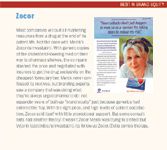
Zocor
The group ultimately recommended that girls should receive the vaccine between the ages of 11 and 12—and up to age 26, if they fail to get it at the recommended time. Girls who are 9 or 10 years old can receive Gardasil at their physician's discretion. In explaining how ACIP chose its target age range, Gilsdorf described one of Gardasil's key challenges—getting adolescent and pre-adolescent girls to go to the doctor—as a public health opportunity.
"The vaccine is licensed for females 9 to 26," she says. "The ACIP generally constrains its recommendations to what vaccines are licensed for. We decided to focus on 11 and 12 year olds because there's a strong movement afoot to establish adolescent visits [to the doctor] at a time of life when people aren't going to the physician for routine care."

Rick Haupt, Merck's executive director of medical affairs
"It was an enormous and appropriate recommendation," Haupt says. "It has huge implications. It sets the standard of medical care of how vaccines are delivered in this country. It drives physician behavior."
And that's just the United States. Similar discussions played out worldwide. Take the European Union: Even though the European Agency for the Evaluation of Medicinal Products, a regulatory body, has approved the vaccine, coverage decisions are made on a country-by-country basis.
The Global Conundrum
The rural communities of India offer a window to the magnitude of cervical cancer in the developing world. There, about one in three women with cancer will see the disease originate in cervical cells, and the country bears the burden of 20 percent of all cervical cancer cases worldwide, according to the International Network for Cancer Treatment and Research.
The disease disproportionately affects poor, uneducated Indian women, and often goes undiagnosed until its advanced stages. The same factors that hinder access to routine gynecologic care also create obstacles for delivering a preventative vaccine.
With Gardasil, Merck faced two audiences: rich countries that can afford to cover the vaccine, but where the threat of disease is blunted by rigorous screening practices; and poorer nations, where a lack of resources is precisely why cervical cancer remains a real and present danger. About 80 percent of cervical cancer cases are diagnosed in the developing world.
The Indian Council of Medical Research has partnered with Merck to host clinical studies of Gardasil. Merck also is working with nonprofit group PATH, on a grant from the Bill & Melinda Gates Foundation, to get lower-priced doses of the vaccine to girls who wouldn't otherwise receive it. "We've been working very closely with non-governmental organizations...to put together important information that would allow access in the developing world," Barr says.
On the other side of the globe, in contrast, the US death rate from cervical cancer has been steadily declining at a rate of about four percent each year, according to the American Cancer Society—and has experienced an overall drop of 74 percent between 1955 and 1992. But Barr disagrees that pap tests have reduced the need for a vaccine here. "The number of people who are told they need to have invasive procedures in a sensitive area of the body not only has costs from a dollar perspective," says Barr, "but also has psychological costs."
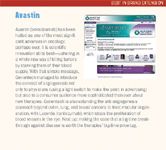
Avastin
In fact, the vaccine's value proposition—both social and economic—has been Merck's key pitch to managed care plans to achieve the same sort of widespread coverage that is necessary in poorer countries. But even Merck insiders admit that it was ACIP's coverage recommendation that really put things in motion. Within five months of ACIP's decision, and by the time Merck launched its big consumer push, CDC had added Gardasil to its Vaccines for Children Contract, providing it free of charge to uninsured girls ages 9 to 18. Most states took up the cause by establishing cervical cancer task forces, and all but one pledged to cover the prophylactic vaccine. The private sector followed their lead, with 95 percent of plans adding Gardasil to their formularies.
Facing the Opposition
Getting the vaccine on formularies only solves the riddle of how to pay for a vaccine that costs around $300 to $500 for three doses. It still leaves open the question of how to get girls to the doctor in the first place.
California, Kentucky, and the District of Columbia are among the jurisdictions that are debating whether to make the vaccine mandatory as a condition for enrolling in school. Yet compulsory vaccination is where Merck and lawmakers are likely to face their stiffest opposition from conservative and religious groups—a constituency that has been largely, perhaps surprisingly, accepting of the vaccine's approval. But their concerns linger. At the center of their opposition is the belief that inoculating girls against an STD might come across as an endorsement of risky sexual behavior—by giving youngsters a false sense of security. They want parents, not the state, to have the final say about when and if to vaccinate to their daughters.
These groups have been no less an audience for Merck's outreach than professional societies or policymakers. "We recognize that there are different voices out there, and we want to make sure that we hear the perspective of those different groups," Haupt says.
Still, it remains to be seen how effective Merck can be against vocal opposition. It is facing not only an organized conservative movement, but also heightened public awareness—and fears—about drug safety and risk. In a recent discussion on The Washington Post's Web site, two groups objected to Washington, DC's proposal for compulsory vaccination: those who objected on the grounds that the shot might encourage promiscuity, and those who worried about long-term risks and side effects that might not be seen until years and thousands of vaccinations later.
Helping Women Find the Words
Some of Merck's most important and exciting work came from reaching out to women themselves, many of whom had never even heard of the human papillomavirus, let alone its link to cervical cancer. "In the past, women thought you developed cervical cancer like any other cancer—they didn't know why it happened," says Jill Rogers, director of marketing research services at AllPoints Research.
In AllPoints' independent Women's Health Study, conducted before Gardasil's launch, only 60 percent of women had heard of HPV. And even if they knew what it was, only 52 percent knew that it could cause cervical cancer or genital warts.
The findings were echoed in other parts of the study. Nearly 60 percent of women who had symptoms of possible sexually transmitted diseases didn't discuss those complaints with their clinicians. Doctors weren't bringing up the subject either; 85 percent of women said their doctors had never raised the issue of how to protect themselves from an STD like AIDS, for instance.
"The medical community did not do a good job of educating women," Rogers says. "It was going to fall to Merck to educate the population about HPV and genital warts. They have done just a superb job of tackling the sensitive aspects of this vaccine."
For Merck's marketing team, the campaign had to be divided into two parts: the unbranded, disease awareness part, and the post-approval, branded part, which finally urged women to "get vaccinated." The company worked with advertising agency DDB and public relations firm Edelman on both pieces.
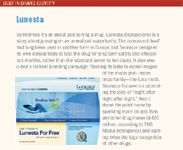
Lunesta
"Make the Connection" was the first phase of the disease awareness effort. The conduit for that connection was beaded bracelet kits that girls could order over the Internet—stringing together the beads, stringing together the facts about HPV and cervical cancer that were included in the accompanying educational packet. Celebrities sported their own beaded bracelets at various events. Merck also pledged to donate $1 (up to $100,000) to the Cancer Research and Prevention Foundation for each kit ordered. The response was so great that maketheconnection.org ran out of kits. "We've had reports of girls getting together to make their own 'Make the Connection' project," Lybrand says.

Bev Lybrand, vice president and general manager for Gardasil
The next evolution of the campaign, "Tell Someone," tapped into "women's natural inclination" as talkers and sharers, Lybrand notes. In no uncertain terms, women were told: don't ignore this, don't be shy, talk about it. Actresses in the TV ads spoke directly to the camera, as if speaking directly to a friend, family member, or simply another girl who needed to know. Sitting down in front of their own computers, girls could send out personalized "Tell Someone" e-cards—imprinted with girls lining up to use the phone or gossiping together at a beauty salon—stamped with the question: "Did you know that cervical cancer is caused by certain types of a common virus?"
"The call to action was to do something about awareness," Lybrand says. "The creative was one of the most fun and well-thought-out pieces of work."
The disease awareness effort did more than just play on cancer fears, but drew on themes of safeguarding your children (for moms) and empowerment (for girls). "Of course everyone understands cancer and is scared of cancer," Lybrand says. But, "We learned early on that moms really wanted to protect their daughters—that protective insight is important. For young women, they want to empower themselves to take control of their own destiny."
The timing for the campaign was fortuitous for Merck, coming on the heels of another HPV-awareness effort. In March 2005, a Maryland-based molecular diagnostics company, Digene, launched its own direct-to-consumer TV and print advertising campaign to introduce its DNA-based HPV test, DNAwithPap. "It's been sort of a progression of information," says L. Jo Parrish, vice president for institutional advancement at the Society for Women's Health Research, which named Gardasil its top women's health story of 2006. "We've talked about pap tests for a long time. The launch of the HPV-DNA test did a lot to make the connection to cervical cancer."
But the launch of Gardasil represented the first time someone could offer a message about prevention—really, one of the first times a drug or vaccine could offer that hope for any cancer. "That's a wonderful message," Parrish says.
Merck's research ahead of the campaign showed that it was dealing with a situation in which only five percent of women and girls surveyed could make the link between HPV and cervical cancer. After the campaign, awareness "rocketed to approaching an excess of 50 percent," says Lybrand. "That was the key metric in terms of whether 'Make the Connection' was resonating."
Then came "One Less," the first ads to mention Gardasil by name. Once again, girls ran, jumped, and danced their way through the spot while pledging to be "one less" cancer statistic—with their supportive mothers standing beside them. "The idea was really to deliver on the strong and powerful message of empowerment," Lybrand says.
Physicians on Board
Analysts have predicted that the vaccine could be a blockbuster, and the early results are encouraging. In his December presentation, Loescher pointed to some early markers. On the policy front, there has been "broad" professional and governmental endorsement. In terms of payers, 80 percent of publicly eligible and 94 percent of insured individuals now have vaccine access. Among physicians, about 50 percent of pediatricians are stocking the vaccine, to look at just one specialty. And among consumers, awareness has increased 10-fold, and sales of the vaccine were $70 million in the third quarter of last year, the last period for which numbers were publicly available at press time.

Celebrex
The launch of the vaccine also gave the company its first opportunity to unveil its new model for reaching out to physicians. Having already pledged to cap the head count of its sales force, Merck redeployed reps to cover the growing vaccine division. Professional outreach included online channels like video-detailing as well as encouraging physician-to-physician communication.
Education efforts had to be tailored to at least three different specialties. Pediatricians knew how to give vaccines but many were less versed in the nuances of HPV. Gynecologists were familiar with the disease but their practices weren't set up to offer vaccinations. Family practitioners skewed somewhere in the middle.
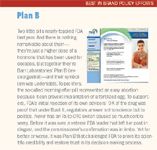
Lunesta
Merck provided unrestricted educational grants to professional societies to help physicians address issues ranging from vaccine inventory, to legally required patient forms, to reimbursement. Vendors specializing in continuing medical education also identified experts who could communicate with other physicians about the vaccine. "We developed resources to help offices understand the logistical side," Haupt says. "We tried to give them as much information about the disease as we could."
To Be Continued ...
Merck execs like to talk about a turnaround for the beleaguered company. "We have the momentum and the credibility," Clark told analysts back in December. "The good news is that we have not declared victory."
In other words, the story of the brand of the year is to be continued. The next phase will focus on whether the vaccine can benefit women ages 26 to 45, as well as its efficacy in boys and men, 10 percent of whom will have at least one episode of genital warts in their lifetime. Merck's researchers are also looking at long-term efficacy data as well as the vaccine's ability to offer "cross-protection" against other cancer-causing strains of HPV. Finally, they are studying its concomitant use with other adolescent vaccines.
"We're interested in determining the impact of the vaccine in the real world," Barr says. "With cervical cancer, it'll take a couple of decades. What we hope to see in a shorter amount of time is a decline in the number of abnormal pap smears...the number of surgical procedures."
The speed and urgency that's driving Merck isn't only about unmet need. The company needs to move fast to capitalize on a first-to-market position, before GlaxoSmithKline's Cervarix throws its hat in the ring. (FDA is expected to review Cervarix's application sometime this year.)
But it is clear from talking to the people who work within the Gardasil franchise that this isn't just another product launch. It's a cause.
"The goal of the company was to create substantial, paradigm-shifting vaccines," Barr says, when asked why the company chose to pursue HPV prevention more than ten years ago. "The burden of the disease in the United States was huge. This work was really the result on the part of the company to focus on something novel."
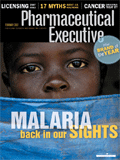
The Misinformation Maze: Navigating Public Health in the Digital Age
March 11th 2025Jennifer Butler, chief commercial officer of Pleio, discusses misinformation's threat to public health, where patients are turning for trustworthy health information, the industry's pivot to peer-to-patient strategies to educate patients, and more.
Navigating Distrust: Pharma in the Age of Social Media
February 18th 2025Ian Baer, Founder and CEO of Sooth, discusses how the growing distrust in social media will impact industry marketing strategies and the relationships between pharmaceutical companies and the patients they aim to serve. He also explains dark social, how to combat misinformation, closing the trust gap, and more.